

Supernatural Summertime: Staying Cool with Scary Stories
|
Summer can get extremely hot and humid in Japan, but there are several ways to beat the heat. People can indulge in icy treats, or take trips to the seaside or mountains for a cool escape. However, did you know that ghost stories too are especially popular in the summertime as a way to cool down? Creepy tales of vengeful ghosts and unexplained phenomena can certainly send a welcome chill down spines on warm nights.
It is not known how ghost stories became associated with the season, but the Japanese have long been enjoying frightening tales in summer. Some posit that the annual event of obon (お盆) may have helped associate ghost tales with the summer: every August, Japanese people commemorate obon, a Japanese Buddhist event during which it is believed ancestral spirits return to earth to visit their relatives. However, it could simply be because getting frightened triggers reactions like cold sweat and shivers, reactions that could be greatly welcome in hot weather. Scary stories about supernatural creatures and unexplained phenomena have been passed down throughout the centuries but it was probably during the Edo Period that the retelling of such tales really came into their own as sources of entertainment. In the Edo Period, a type of parlour game called Hyakumonogatari Kaidankai (百物語怪談会) became popular among people. Played at night, this game required players to gather at night with three rooms prepared: one for storytelling, one for 100 lit paper lanterns, and one with a mirror. One by one, players would tell a ghost story, after which, they would go into the next room to extinguish a light in one of the paper lanterns, look in the mirror, and return to their seat. With each passing turn, the rooms would grow darker and darker. Players would eventually stop before reaching the hundredth tale, out of fear that spirits would really come once they completed the game. |
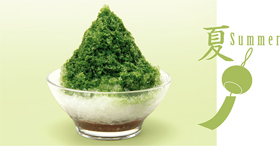 © TORAYA Confectionery Co. Ltd. 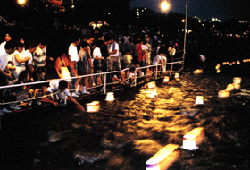 © Tokyo Metropolitan Government 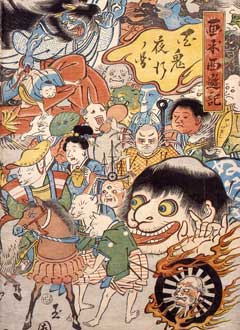 © The Tsubouchi Memorial Theatre Museum, Waseda University |
|
“Urameshiya…” Players would regale each other with tales of vengeful spirits that passed under unfortunate circumstances, sorrowfully cursing those who did them wrong. Stories of such begrudged spirits, known as yuurei (幽霊), featured prominently in the game, and remain popular till today. Those who are familiar with Japanese horror may recognise the stories ‘Yotsuya Kaidan,’ ‘Sarayashiki,’ and ‘Botandourou,’ all of which feature spirits that haunt the living because of grudges or unfinished business.
Another common theme that featured in this game is the legend of Hyakkiyagyou (百鬼夜行), which means “Night Parade of One Hundred Demons.” The origin of this legend is unclear but it is said that every year on a summer night, all the yokai (‘妖怪,’ a word used generally to describe supernatural monsters in Japanese folklore) would be led in a night procession down the streets of Japan. Anyone unlucky enough to come across the procession would be spirited away by the yokai. This theme was also commonly depicted in scroll paintings, known as emaki (絵巻) in Japanese. Interestingly, the yokai featured in many hyakkiyagyou emaki tend to be tsukumogami (つくも神). Tsukumogami are household tools and utensils that come back to life as spirits after being thrown away. Depictions of tsukumogami have been discovered in emaki from as far back as the Muromachi Period, but they still retained much popularity late into the Edo Period as well. Playful renderings of yokai in the shape of baskets and miso strainers were not uncommon to see in such scrolls. Illustrated demons also live on in contemporary times in manga; artists like Junji Ito have gained explosive popularity not only in Japan and overseas for their innovative takes on classic Japanese horror, while others, like Shigeru Mizuki and Rumiko Takahashi, to name a few, have reinterpreted traditional yokai for modern audiences in different genres. For those brave enough, haunted houses are also a popular option for frights in the summertime! Obakeyashiki (お化け屋敷), were first popularised in Japan during the Edo Period as entertainment. Now, large commercial haunted houses can be found at amusement parks and shopping complexes during the summertime. Smaller ones are also sometimes constructed at summer festivals. Obakeyashiki make use of Japan’s rich folklore to come up with a frightening experience within its walls. In the 1990s, Gomi Horifumi, along with his team at Luna Park, designed a novel haunted house experience. Gomi came up with a backstory to the haunted house and instructed visitors to complete a mission: they were each given dolls and told to escort it through “hell” and safely to the exit. This format pioneered a new breed of haunted houses, and they became more popular than before, with organisers competing each summer to show off the scariest and most creative obakeyashiki. With so many ways to experience Japanese ghost stories, why not try one of these methods for a thrill when it gets too hot? |
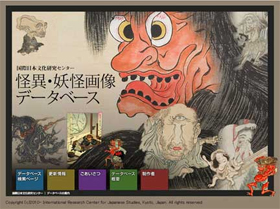 © International Research Center for Japanese Studies 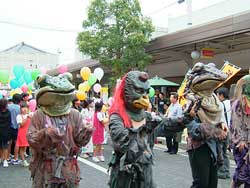 © Sakaiminato City 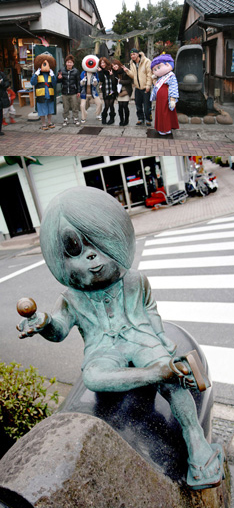 © Mizuki Production 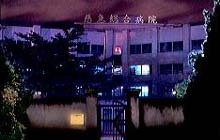 © Fujikyu-Highland |
Resources
|
Chilling Summer: Arts and Entertainment: Trends in Japan: Web Japan. https://web-japan.org/trends00/honbun/tj991014.html |
|
Japan Creative Centre 4 Nassim Road, Singapore 258372 +65 6737 0434 / jcc@sn.mofa.go.jp https://www.sg.emb-japan.go.jp/JCC/ Nearest parking at Orchard Hotel & Delphi Orchard |
 |